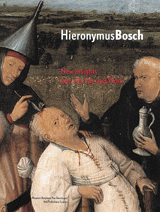
Vellekoop 2001
“Music and Dance in the Paintings of Hieronymus Bosch” (Kees Vellekoop) 2001
[in: Jos Koldeweij, Bernard Vermet and Barbera van Kooij (eds.), Hieronymus Bosch. New Insights Into His Life and Work. Museum Boijmans Van Beuningen-NAi Publishers-Ludion, Rotterdam, 2001, pp. 200-205]
The musical instruments that Bosch painted have a realistic and a fantastical aspect. They are realistic because in most cases they have been rendered in a very faithful way and because they occurred in similar contexts in Bosch’s time. They are fantastical because they are often strangely shaped, incorporated in monstrous creatures or unplayable in real life. Very often the environment in which the instruments occur, is also fantastical.
First Vellekoop provides us with a list of musical instruments, dancers and musicians that occur in the works of Bosch and then he analyses them somewhat deeper. Bosch may have derived the motif of the naked man who is being pierced by the strings of a giant harp on the right wing of the Garden of Delights from the Church Fathers who saw in the harp a figura crucis, an instrument of torture inflicted on those who committed sins of the flesh. This harp and the lute next to it rest on an open book of music. A plausible reason for this detail is probably that lutenists and harpists were the only musicians besides singers and organists who could read music. In the Middle Ages the belly of a lute was sometimes compared to the belly of a woman. This erotic symbolism may also play a role on the central panel and right wing of the Vienna Last Judgment. The lead seal hanging from a bowl which is held by the man on top of the giant hurdy-gurdy (right wing of the Garden of Delights) confirms that this man is a beggar (lead seals like this one became compulsory for all beggars under the terms of an edict issued by Philip the Good in 1459) and that the hurdy-gurdy was a beggar’s instrument. The instrument inserted into the behind of a man is clearly a flute and not a recorder. The giant instrument on this man’s back is a shawm.
On the central panel of the Tempations of St. Anthony (Lisbon) a skull-monster seated on a plucked goose plays a harp. Can this be a late echo of the ‘ass with a harp’ motif so frequently encountered in romanesque sculpture (according to Vellekoop the head of the monster is an ass’s skull)? In the Luxuria scene of the Prado Tabletop with the Seven Deadly Sins a harp, a recorder and a drum are lying on the ground. Was it Bosch’s intention to point out that he considered all earthly instruments to be symbols of luxury? The bagpipe is mostly presented as a typical instrument of shepherds and peasants in Bosch’s works. The bagpipe on the central panel of the Haywain clearly has an erotic connotation: the shape of a bagpipe is similar to that of the male genitals.
Obviously musical instruments play an important role in Bosch’s paintings, not only in their traditional context but also as instruments of torture. Especially on the right wing of the Garden of Delights people are being punished in hell for sins they have committed with their ears. The giant ears with a knife between them (upper half of the right wing) bear out this interpretation.
This contribution is useful when it comes down to identifying the musical instruments which Bosch painted. Their iconographical interpretation is rather mediocre, though.
[explicit]